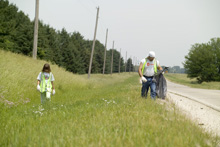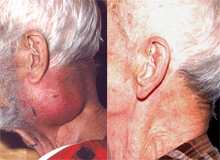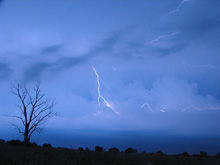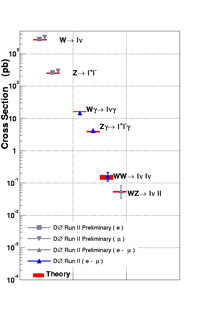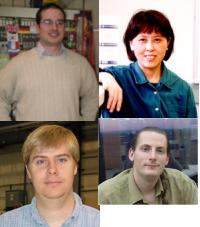 | Thursday, July 20, 2006 |
|
Thursday, July 20
Friday, July 21 Click here for a full calendar with links to additional information. |
|
Extended Forecast |
Secon Level 3 |
|
Thursday, July 20 -Santa Fe Black Bean -Sloppy Joe -Stuffed Peppers -Sauteed Liver & Onions -Baked Ham & Swiss on a Ciabatta Roll -Assorted Slice Pizza -Crispy Fried Chicken Ranch Salad |
|
Thursday, July 20
Wednesday, July 26
Chez Leon Menu |
| Fermilab Today is online at: http://www.fnal.gov/today/ Send comments and suggestions to today@fnal.gov Fermilab Today archive Hurricane Relief Page Fermilab Today PDF Version Fermilab Result of the Week archive Fermilab Safety Tip of the Week archive Linear Collider News archive Fermilab Today classifieds Subscribe/Unsubscribe to |
| |||
| There will be a volunteer cleanup today at 11:45 a.m. (If weather conditions worsen before time of departure, call Bob Lootens at x3303 to make sure the cleanup has not been cancelled.) The target areas include inbound Pine Street starting at Kirk Road, C Road, and Old Batavia Road. A bus will transport volunteers, leaving at 11:45 a.m. sharp at Wilson Hall Ground Floor-East side. After the cleanup, the bus will pick up people earlier than usual (12:30 p.m.) due to the weather. Lunch will be at the Lederman Science Center picnic area. You can find more information here. |
|
|
Scientific American, July 17, 2006: A Hint of Axions: An experiment may have seen an elusive new particle Named after a laundry detergent and originally proposed to clean up a problem with particle physics, axions are curious critters. Axions produced during the big bang could be lurking all around us, contributing to the dark matter that constitutes 22 percent of the universe. Other axions, freshly formed inside the sun, could be streaming through us. And according to a paper published in March, laboratory-made axions might have been detected for the first time by an experiment in Italy known as PVLAS (polarization of the vacuum with a laser).
Axions are posited to have exceedingly low mass--less than a millionth that of an electron--and are electrically neutral. They interact only very weakly with other particles, making detection difficult. But physicists predict that a tiny fraction of any photons passing through a magnetic field will change into axions. (That is how the sun is predicted to produce them.) Indeed, the Italian experiment, based at the National Laboratories of Legnaro and led by Emilio Zavattini and Giovanni Cantatore of the INFN Trieste, saw evidence for axions in the behavior of a laser beam. The beam's polarization was rotated by 10 millionths of a degree after transiting 44,000 times back and forth through an extremely strong magnetic field. Such rotation is just the fingerprint expected if some photons converted to invisible axions, or more precisely, what physicists call axionlike particles.
|
| First Evidence for WZ Production | |||
| |||
|
The Standard Model of particle physics predicts that the colliding protons and antiprotons at the Tevatron should produce events containing two vector bosons, W's and Z's. This signature is of particular interest to particle physicists, as the coupling of the weak vector bosons to one another is an important consequence of the non-Abelian nature of the Standard Model. The rate for the associated production of W and Z bosons in proton antiproton collisions allows physicists to probe this coupling. In addition, measuring the cross section times branching ratio for such low rate Standard Model processes is an important stepping stone in the search for the Higgs boson at the Tevatron.
The DZero collaboration at Fermilab has announced the first measurement of the WZ production cross section in proton-antiproton collisions. Events in which both the W and Z boson decay to leptons are used to make this measurement. Such events provide the cleanest signature of WZ events, but constitute only 1.4 percent of all WZ decays. Twelve events with three high transverse momentum charged leptons and missing transverse energy (indicating the presence of an undetected neutrino were found with an expected background of 3.6 +/- 0.2 events. The probability for the background to account for these twelve events is 4.1x10-4 which constitutes 3.3 sigma evidence for WZ pair production. The cross section times branching ratio for this process is the smallest ever measured at a hadron collider. The WZ production cross section is measured to be 4.0 (+1.9 -1.5) pb which is consistent with the Standard Model prediction of 3.6 +/- 0.3 pb. The data for the DZero result were taken from more than 1 inverse femtobarn of total collision data, and a sample of 1.5 billion recorded events. | |||
| |||
| Result of the Week Archive
|
|
July 17 - 19 - Booster has BRF17 trouble - Linac's line voltage sags - Stash lost - MI has BPM problems - LCW temperatures rise Read the Current Accelerator Update Read the Early Bird Report View the Tevatron Luminosity Charts
|
|
International Folk Dancing International Folk Dancing will meet Thursday, July 20, in Ramsey Auditorium in Wilson Hall. Dancing begins at 7:30 p.m. with teaching earlier in the evening and request dancing later on. Newcomers are welcome and you do not need to come with a partner. Info at 630-584-0825 or 630-840-8194 or folkdance@fnal.gov.
East entrance to close July 29 |
